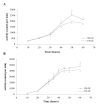Influence of oxygen on asexual blood cycle and susceptibility of Plasmodium falciparum to chloroquine: requirement of a standardized in vitro assay
- PMID: 17437625
- PMCID: PMC1855060
- DOI: 10.1186/1475-2875-6-44
Influence of oxygen on asexual blood cycle and susceptibility of Plasmodium falciparum to chloroquine: requirement of a standardized in vitro assay
Abstract
Objective: The main objective of this study was to assess the influence of gas mixtures on in vitro Plasmodium falciparum growth and 50% inhibitory concentration (IC50) for chloroquine.
Methods: The study was performed between February 2004 and December 2005. 136 Plasmodium falciparum isolates were used to evaluate gas mixtures effect on IC50 for chloroquine by isotopic microtest. The oxygen effect on asexual blood cycle of 3D7 and W2 clones was determined by thin blood smears examination and tritiated hypoxanthine uptake.
Results: From 5% O2 to 21% O2 conditions, no parasiticide effect of O2 concentration was observed in vitro on the clones 3D7 and W2. A parasitostatic effect was observed during the exposure of mature trophozoïtes and schizonts at 21% O2 with an increase in the length of schizogony. The chloroquine IC50 at 10% O2 were significantly higher than those at 21% O2, means of 173.5 nM and 121.5 nM respectively (p < 0.0001). In particular of interest, among the 63 isolates that were in vitro resistant to chloroquine (IC50 > 100 nM) at 10% O2, 17 were sensitive to chloroquine (IC50 < 100 nM) at 21% O2.
Conclusion: Based on these results, laboratories should use the same gas mixture to realize isotopic microtest. Further studies on comparison of isotopic and non-isotopic assays are needed to establish a standardized in vitro assay protocol to survey malaria drug resistance.
Figures






References
-
- WHO Susceptibility of Plasmodium falciparum to antimalarial drugs. Reports on global monitoring 1996-2004.
-
- Le Bras J, Musset L, Clain J. Antimalarial drug resistance. Med Mal Infect. 2006;36:401–405. - PubMed
Publication types
MeSH terms
Substances
LinkOut - more resources
Full Text Sources

